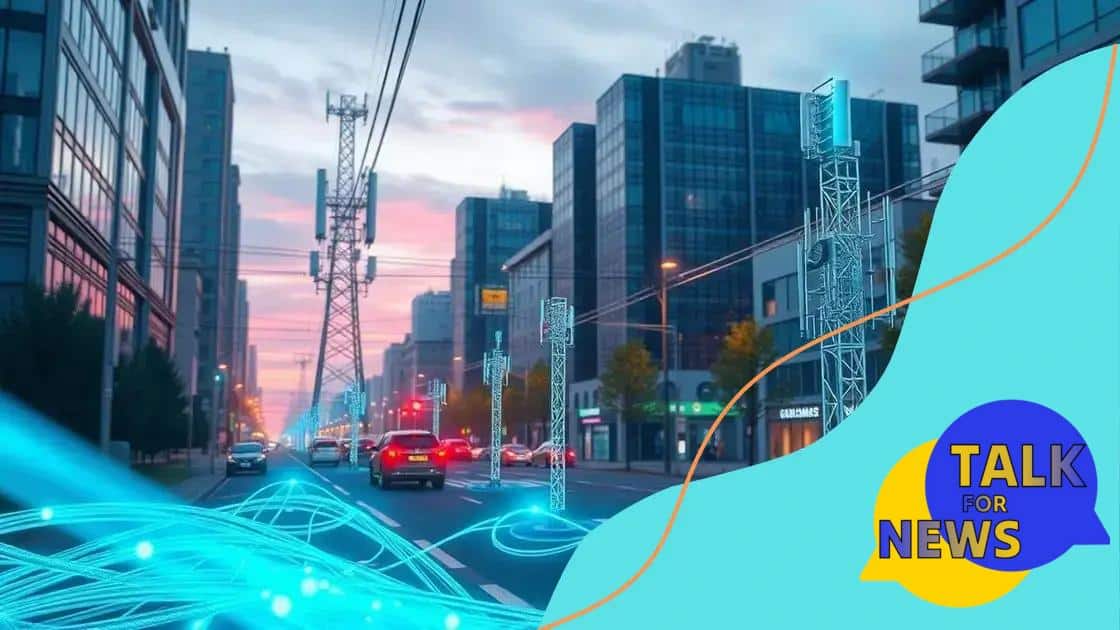The impact of 5G on urban infrastructure development

Anúncios
The impact of 5G on urban infrastructure development is significant, enabling smarter cities, improved public services, and enhanced connectivity, while also presenting challenges such as high costs and regulatory hurdles.
The impact of 5G on urban infrastructure development is profound, reshaping how cities function. Have you considered how faster connectivity might transform your daily life? Let’s dive into this technological revolution.
Anúncios
Understanding 5G technology
Understanding 5G technology is essential as we shift to a more connected world. This next generation of mobile communication brings unprecedented speed and connectivity, enabling various applications that can profoundly impact our daily lives.
One of the critical aspects of 5G is its ability to support a massive number of devices simultaneously. This technology allows for a seamless connection between various devices, whether in your home or across an entire city.
Key Features of 5G
Anúncios
5G technology stands out for several reasons:
- Faster Speeds: 5G offers download speeds that can reach up to 100 times faster than 4G.
- Lower Latency: It significantly reduces lag, allowing for real-time communication.
- Increased Capacity: 5G can support up to one million devices per square kilometer.
The impact of 5G extends beyond just smartphones. It will enhance services like smart cities, autonomous vehicles, and Internet of Things (IoT) technologies. Moreover, industries, from healthcare to manufacturing, will experience transformations as they adopt 5G capabilities.
Benefits of 5G for Urban Areas
This technology will streamline processes, improve efficiency, and even contribute to environmental sustainability. For example, smart traffic systems powered by 5G can help reduce congestion and lower emissions.
Additionally, remote work and telemedicine will thrive due to the enhanced connectivity provided by 5G. Imagine a world where you can consult a doctor in real time, regardless of your location. It’s not just a dream; it’s becoming a reality.
Understanding 5G technology lays the foundation for harnessing its benefits for urban infrastructure development. As cities evolve, embracing this technology will be crucial for creating smarter, more efficient communities.
Key benefits of 5G for urban areas
The key benefits of 5G for urban areas are transforming how cities operate. This technology is not just about speed; it enhances connectivity and efficiency throughout urban environments.
5G enables faster data transfer speeds, which means applications and services can run more smoothly. Imagine a city where traffic signals sync with real-time traffic data to optimize flow.
Enhanced Connectivity
Another significant benefit is enhanced connectivity. As more devices connect to the internet, 5G supports this demand effectively. With its capability to connect more devices, smart city initiatives can become a reality.
- Support for IoT: A robust IoT ecosystem allows smart sensors and devices to communicate effectively.
- Improved Public Safety: Enhanced communication networks can support emergency services better.
- Smart Public Services: Services like waste management and energy distribution can operate more efficiently.
This level of connectivity also encourages innovation. Businesses can develop new applications, ranging from mobile health solutions to augmented reality experiences, that benefit from the speed and efficiency of 5G.
Economic Growth
5G has the potential to stimulate economic growth. Cities that implement this technology can attract businesses looking for an advanced infrastructure.
Moreover, with enhanced bandwidth and lower latency, digital services can expand, allowing residents to access high-quality internet for education and remote work. The benefits reach deep into our society and change how we interact with our environment.
In essence, the key benefits of 5G for urban areas create opportunities for better living conditions and work environments. As cities embrace this technology, they are likely to become more efficient and connected than ever before.
Infrastructure upgrades needed for 5G

Infrastructure upgrades needed for 5G are essential to fully realize its potential in urban settings. As cities aim to enhance their connectivity, certain key improvements are necessary.
First, a robust fiber optic network is crucial. With the demand for higher data speeds, existing networks must be updated or expanded. Fiber optics deliver fast internet speeds that are vital for supporting 5G connections.
Essential Upgrades
Here are some significant upgrades that cities need to consider:
- Small Cell Deployments: These are necessary to improve coverage in densely populated areas.
- Network Slicing: This technology allows operators to create virtual networks tailored to specific needs.
- Enhanced Data Centers: Upgrading data centers improves processing power, crucial for managing the increased data traffic from 5G.
Moreover, upgrading existing cellular towers is vital. These towers must support the high-frequency bands that 5G uses. The installation of new antennas and equipment can significantly enhance signal strength and quality, ensuring broader coverage.
Integration with Existing Systems
Cities should also integrate 5G with current public infrastructure. For instance, incorporating smart traffic lights and connected street furniture can optimize urban mobility. By utilizing technologies such as IoT and machine learning, cities can analyze data from these upgrades for better efficiency.
Finally, collaboration between local governments and service providers is crucial. Working together can help streamline the implementation of these critical upgrades, making sure citizens can enjoy the full benefits of 5G connectivity.
Challenges of implementing 5G in cities
The challenges of implementing 5G in cities are significant but manageable. As cities strive for better connectivity, several hurdles must be addressed to ensure a seamless rollout.
One of the primary challenges is the cost associated with upgrading existing infrastructure. Installing new equipment and expanding fiber optic networks can require substantial investment. Cities need to evaluate budgets and find funding sources to meet these needs effectively.
Regulatory and Zoning Issues
Another major hurdle is navigating complex regulatory and zoning issues. Different municipalities may have varying regulations regarding the placement of antennas and small cell towers. This inconsistency can lead to delays in deploying necessary technology.
- Permitting Delays: Obtaining the required permits for installations can prolong the timeline.
- Community Concerns: Some residents may have concerns about health effects or aesthetics.
- Access to Public Infrastructure: Collaborating with local utilities is essential but can be complicated.
Moreover, ensuring the reliability of 5G networks presents its own set of challenges. The technology depends on a dense infrastructure to provide coverage without interruptions. This necessitates careful planning of locations for small cells to optimize coverage.
Technical Challenges
There are also technical obstacles to consider. For instance, low-frequency 5G can travel longer distances but may not offer the same speeds as high-frequency 5G, which has a shorter range. Balancing these requirements is key.
Lastly, cybersecurity is a pressing concern. As urban areas become increasingly connected, the risks of hacking and data breaches grow. Cities need to implement strong security measures to protect sensitive information and maintain public trust.
Future trends in urban development with 5G
Future trends in urban development with 5G technology are shaping how cities will grow and function. As this technology evolves, it will influence a wide range of urban aspects.
One key trend is the rise of smart cities. With 5G, cities can utilize data to enhance services and improve the quality of life for residents. Imagine smart systems that monitor energy use and adjust in real-time to reduce waste.
Transportation Innovations
The transportation sector will also see major changes. With 5G, autonomous vehicles can communicate with each other and with traffic management systems. This communication can lead to safer and more efficient travel.
- Real-time Traffic Management: Smart traffic lights can adapt based on current traffic flow.
- Shared Mobility Services: Apps will connect users with available rides quickly.
- Environmental Monitoring: Cities will track pollution levels and make necessary adjustments.
Additionally, 5G will enhance public safety through improved communication networks. Emergency services can operate more effectively, with faster response times. Surveillance systems can also use 5G to transmit data rapidly.
Economic Development
As cities adopt 5G, we can expect to see economic growth driven by new technologies. Startups and established companies will leverage high-speed internet to innovate and improve services. This trend will attract investments and create jobs.
Moreover, remote work will become more viable as 5G provides stable and fast internet connections. This flexibility could lead to a decrease in urban congestion as more people choose to work from home.
In summary, the future of urban development with 5G looks promising. Cities are set to become smarter, more efficient, and more connected, paving the way for a better living environment.
FAQ – Frequently Asked Questions about 5G and Urban Development
What is 5G technology?
5G technology is the fifth generation of mobile networks that offers faster speeds, lower latency, and increased connectivity for various devices.
How will 5G improve urban infrastructure?
5G will enhance urban infrastructure by enabling smart city technologies, improving public services, and facilitating real-time data usage to optimize resources.
What are the challenges in implementing 5G in cities?
Challenges include high costs for infrastructure upgrades, regulatory hurdles, and ensuring robust cybersecurity measures.
What trends can we expect in urban development with 5G?
We can expect trends like smarter transportation systems, economic growth through innovation, and improved public safety services due to enhanced communication.





